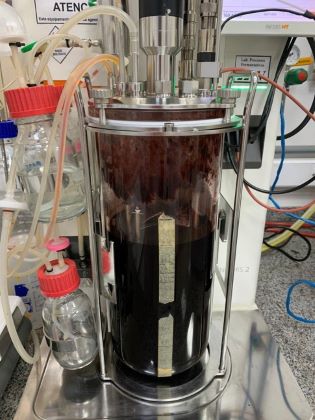

Dried and lyophilized colorant (photo: researchers’ archive)
The process designed by researchers at São Paulo State University (UNESP) in Brazil and collaborators in Chile and Mexico results in low-cost raw materials and reduced environmental damage.
The process designed by researchers at São Paulo State University (UNESP) in Brazil and collaborators in Chile and Mexico results in low-cost raw materials and reduced environmental damage.

Dried and lyophilized colorant (photo: researchers’ archive)
By Thais Szegö | Agência FAPESP – Oranges are an important crop grown in many parts of the world, but there are problems with the orange juice industry, such as the production of some 10 million metric tons of waste per year, 50% of which corresponds to fresh fruit juice, since the juice processing facilities usually discard a significant portion of the fruit (45%-55%) as waste. Not only this represent environmental pollution but also an economic loss, as the residues contain several substances that could be used for industrial and commercial purposes, such as fermentable sugars, polysaccharides, polyphenols and essential oils.
With this problem in mind, scientists at São Paulo State University (UNESP) in Brazil, in collaboration with researchers at the Pontifical Catholic University of Valparaíso (PUCV) in Chile and the Tec Monterrey School of Engineering and Science in Mexico have developed a system to produce biocolorants and enzymes from the orange juice industry’s waste. They present an economic analysis of the process in an article published in the journal Sustainable Chemistry and Pharmacy.
To conduct the study, which was supported by FAPESP (projects 14/01580-3, 19/15493-9, 21/06686-8 and 21/09175-4), they used a biorefinery, an industrial facility that processes renewable inputs such as plants and organic waste to produce a wide array of useful outputs, including energy, fuels, materials, and chemicals, in a similar manner to an oil refinery but using natural ingredients instead of petroleum.
“It’s a comparatively sustainable approach to producing goods and energy because it reduces reliance on non-renewable resources, supplies low-cost raw materials, and decreases waste, pollution, dissemination of diseases, ecological damage and other problems relating to disposal of these residues in the environment,” said Valéria de Carvalho Santos Ebinuma, a professor in the Department of Bioprocess Engineering and Biotechnology at UNESP’s School of Pharmaceutical Sciences in Araraquara, and a member of its Bioproducts Production and Purification Laboratory (BioPPul).
Many kinds of waste from food and agroindustrial processing, such as sugarcane bagasse and straw, as well as orange peel, are rich in cellulose and hemicellulose, which after hydrolysis break down into glucose and xylose respectively. These fermentable sugars can be used as carbon sources to obtain commercially valuable bioproducts, including colorants and enzymes.
“Our research group has focused on studying the production of different natural colorants from microorganisms, so we combined these two kinds of knowledge to propose the project, which Caio de Azevedo Lima wrote up for his master’s thesis,” Ebinuma said.
To this end, the researchers cultured microorganisms in a liquid medium to produce the biomolecules of interest, carefully monitoring the system to ensure that temperature, pH, nutrient levels and other variables were optimal. When the microorganisms reached the desired growth and production rates, they interrupted the culture and retrieved the biomolecules, typically by separating them from the liquid medium for later purification.

Bioreactor tank agitated during production of microbial colorant (photo: researchers’ archive)
“Submerged culture is widely used in the biotech industry to produce a variety of products as it’s an approach that permits precise control of culture conditions in order to maximize output of the biomolecules of interest,” Ebinuma said.
The microbial colorants are already being produced and can be used in future by the food, textile and pharmaceutical industries. However, more R&D is still needed to make the process competitive with those used to produce other colorants available on the market, especially synthetic ones. The molecules must also pass toxicity tests, which are being conducted by partner teams.
According to Ebinuma, the project is a response to growing demand from an expanding market. “Research incentives such as those offered by FAPESP are essential to the development of projects that can bring novel products to market. This project is set to bear fruit of great significance,” she said.
The article “Process development and techno-economic analysis of co-production of colorants and enzymes valuing agro-industrial citrus waste” is at: www.sciencedirect.com/science/article/abs/pii/S2352554123002383.
Republish
The Agency FAPESP licenses news via Creative Commons (CC-BY-NC-ND) so that they can be republished free of charge and in a simple way by other digital or printed vehicles. Agência FAPESP must be credited as the source of the content being republished and the name of the reporter (if any) must be attributed. Using the HMTL button below allows compliance with these rules, detailed in Digital Republishing Policy FAPESP.





